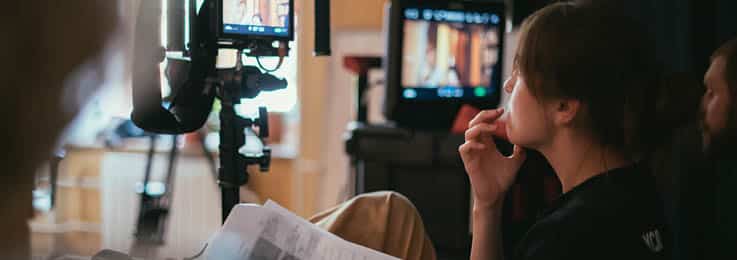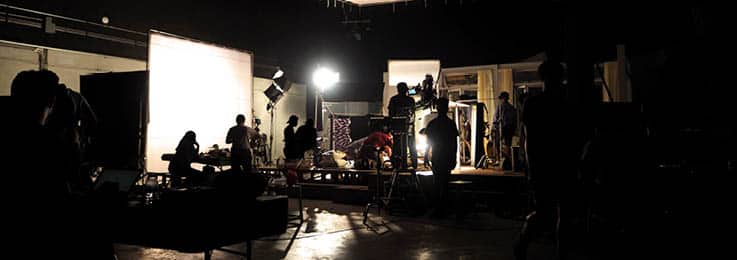
If you’ve been on a film set you will have witnessed the collaborative spirit of a team working together to make a script come to life. You may have wondered who oversees this operation? Some may assume that the director is in charge of everything, but it’s the assistant director who acts as the glue between all departments and ensures that the production runs efficiently.
The assistant director’s role is to liaise with the director and all department heads on a film set to ensure that the production runs on schedule. Their job is to balance the logistical needs of production with the creative needs of the team, and align plans and schedules with the team’s requests.
Having an exceptional assistant director is a great asset to any production. On a film set, time is money. An assistant director who is in command of planning and scheduling will not only help run an efficient set, but also maximize the film’s budget.

What Does An Assistant Director Do?
Anya Adams, first assistant director of Blackish, explains her role by breaking down the responsibilities of an assistant director (AD) into pieces: the prep piece and the shooting piece.
During prep, the AD will break down the script to determine the essential elements needed for each scene, and send this information to the relevant production team and crew members.
Once they have the scene-specific information, an AD will build a practical schedule that accounts for all departments’ needs. They will also make sure that the call sheets are sent out to the cast and crew detailing the following day’s schedule, and work with the director and director of photography to create storyboards and shot lists.
When on set, one of the main roles of an a director is to work with the department heads to make sure that each shot planned for the day is captured within the designated time frame. If production is running behind schedule, the AD will make the final call on which shots to get to fulfill the director’s vision in the best way possible.
The AD also plays a key safety role on set and needs a thorough knowledge of safety standards and practices. This is especially important in a post-pandemic world where additional COVID-19 health and safety measures have been put in place on all film sets.
Helpful Resource from Celtx: Free call sheet templates for download

4 Skills That Make for A Great Assistant Director
Exceptional Communication
A great AD will have exceptional communication skills. While each department works on its designated roles, the AD will be in constant communication with the department heads to track their progress and to explain to them what needs to be done. When communicating with the crew, they have to invoke a sense of authority while still being approachable.
Problem-Solving
A great AD will preempt problems before they occur. When something goes wrong, they need to be the voice of calm and reason and quickly come up with a plan to solve the problem.
Great Organizational Skills
From scheduling to coordinating the shoot, planning and running a production requires the ability to juggle all moving parts at the same time. The AD needs to have the organizational skills and attention to detail required to run such a complex operation.
Good Time Management
On a regular shooting day, every minute is accounted for. A great AD will work with the cast, crew, and director to ensure that all the scenes and shots are captured within the designated 12-hour shoot day and that no time is wasted.
Related Celtx Blog Article: Essential AV Script Template for Better Video Scripts

How Do You Become an Assistant Director in Film?
Many ADs start their careers by receiving first-hand production experience working in various capacities on set (as a production assistant, for example). Since there is no formal training required to become an AD, someone who has already worked in different set positions may later seize the opportunity to use their skill set and talents to take on a new role as an AD.
If you would like to become an AD by attending a formal training program, the Director’s Guild of America is offering an Assistant Director Training Program, a two-year course that places trainees on sets of features and television series in New York City.

What’s the Difference Between a Director and an Assistant Director?
In the past, aspiring directors used to take on the AD role as a stepping stone. One of the most prominent examples is Alfred Hitchcock who started his directing career as an AD.
Over time, the role of this position has changed. Today, an AD plays a management and coordination function. They are only involved in creative decision-making for short periods and only as these decisions relate to scheduling and other logistical decisions.
A film director, on the other hand, is the person whose creative vision is being executed by the whole cast and crew. The AD is in service to the film director and works to help the director fulfill their creative vision.

The Difference Between a First AD and a Second AD?
On most productions, there will be more than one assistant director. The crew member directly below the AD (also known as the First AD), will be the Second AD. The Second AD assists the First AD in making sure that the production runs efficiently and on time.
The Second AD’s main responsibilities are:
- Coordination: The Second AD will act as the contact person for stand-ins and extras, and will direct them in large scenes.
- Call sheets: The Second AD is responsible for creating daily call sheets that outline the following day’s schedule and send them out to cast and crew a day prior.
The Bottom Line
An AD is the voice of the set and no doubt plays one of the most essential roles in making sure that production gets completed successfully. Even though there are no set rules on how to become an AD, it is certainly a road that requires perseverance, great leadership skills, and a lot of hard work.
Are you looking for professional tools for an assistant director or another video production team role? Celtx all-in-one scriptwriting and video production solution offers an integrated web-based studio with essential planning features like shot lists, storyboards, and schedules to keep your production on schedule and on budget.
Get all of the studio tools free for your first 7 days, when you sign up for a Celtx trial.

